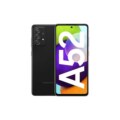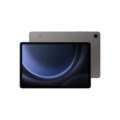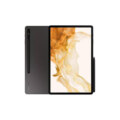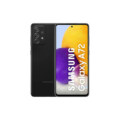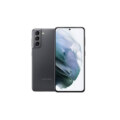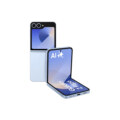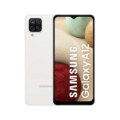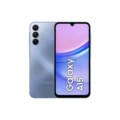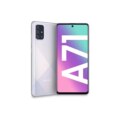Samsung Galaxy Tab S9
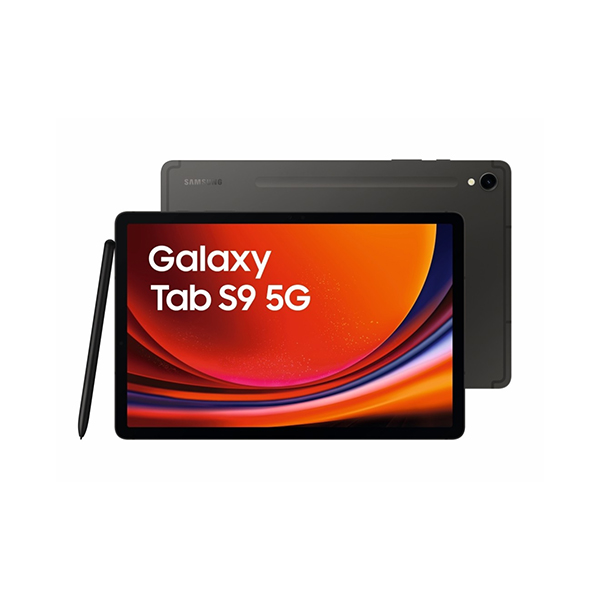

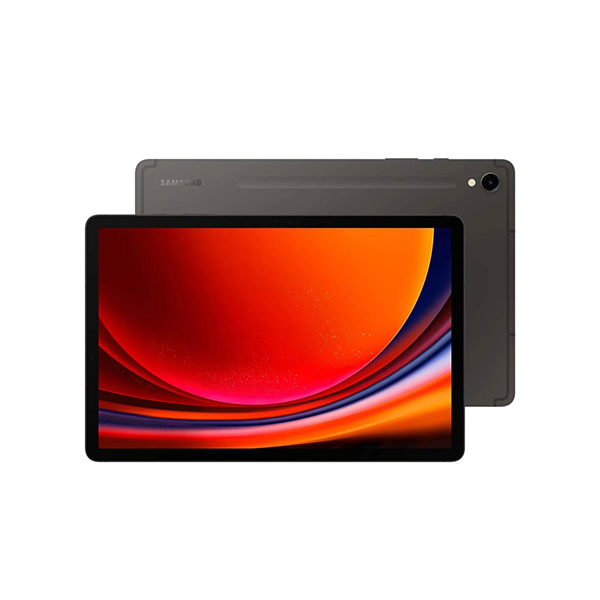
Specs
General
| Device Type | Samsung Tab |
| Model | Galaxy Tab S9 |
| Announced | 26 July, 2023 |
| Status | Available |
Design
| Water Resistant | IP68 dust/water resistant (up to 1.5m for 30 min) |
| Dimensions | 254.3 x 165.8 x 5.9 mm |
| Weight | 498 g |
| Protection | Glass front, aluminum frame, aluminum back |
| Colors |
Beige Graphite |
Display
| Refresh Rate | 120 Hz |
| Display Type Display Technology => A number of display technologies and types used in mobile phones => TFT (Thin Film Transistor), IPS (In-Place Switching), OLED (Organic Light Emitting Diode), AMOLED (Active-Matrix Organic Light-Emitting Diode), Super AMOLED (an even advanced version of AMOLED), Resistive Touchscreen (Resistive touchscreens contain two layer of conductive material with a very small gap between them which acts as a resistance), Capacitive Touchsceen (Capacitive touchscreen technology consists of a layer of glass coated with a transparent conductor) | Dynamic AMOLED 2X |
| Size | 11.0 inches |
| Resolution | 1600 x 2560 pixels |
| Pixel Density Pixel Density (PPI) is refers to the concentration of pixels on a particular display, measured in pixels per inch (ppi). Pixel density is calculated by dividing the diagonal pixel resolution of a display by its diagonal size, higher pixel density better display quality. | ~ 274 ppi |
| Touch Screen | Capacitive Touchscreen, Multi-touch |
| Display Protection Display Protection => Gorilla Glass is a special alkali-aluminosilicate glass shield with exceptional damage resistance that helps protect mobile displays from scratches, drops, and bumps of everyday use, It is always better to go for a smartphone with Gorilla Glass for that added protection and peace of mind. | Corning Gorilla Glass |
| Secondary Display | No |
Camera
| Front Camera | 12 MP |
| Camera Setup | Single |
| Main Camera Camera is able to capture photographs and usually videos, The most important characteristics of a camera are the resolution (measured in megapixels), lens focus type (fixed or automatic), higher megapixel cameras are known to capture higher quality photos, but not always a good measurement of the photos quality. | 13 MP, f/2.0, 26mm (wide) |
| Image | 4128 x 3096 Pixels |
| Video | 4K@30fps, 1080p@30fps |
| Camera Features | HDR, panorama |
| Flash Flash Light => There is commonly two types of flash lights are used in camera mobile phones, LED Flash (LED flash offers lower power consumption with drive circuitry that takes up very little room, LEDs can be strobed faster than any other light source), Xenon Flash (xenon flash produces an extremely intense full-spectrum white light for a very short duration) | LED flash |
Hardware
| Operating System OS => Every computer system run on a base software called Operating System (OS). Operating System controls all basic operations of the computer (such as smartphone, PDAs, tablet computers and other handheld devices). The Operating System allows the user to install and run third party applications (apps), apps are used to add new functionality to the device. | Android 13 |
| Chipset Chipset is a group of integrated circuits designed to perform one or a more dedicated functions, often with real time computing constraints, Popular smartphones are equipped with more advanced embedded chipsets that can do many different tasks depending on their programming. | Qualcomm Snapdragon 8 Gen 2 |
| CPU CPU (Central Processing Unit) mostly known as processors, CPU processes instructions in order to carry out certain functions that make your device operate properly. Processors are often described as the brain of computers, smartphones and tablets, Smartphones and tablets rely on processors to carry out their every task, Processors are an incredibly important factor in selecting any type of computing device, including your smartphone. | Octa-core (1x3.36 GHz Cortex-X3 & 2x2.8 GHz Cortex-A715 & 2x2.8 GHz Cortex-A710 & 3x2.0 GHz Cortex-A510) |
| Architecture | 64 bit |
| Fabrication | 4 nm |
| GPU GPU (Graphics Processing Unit) is a single-chip processor designed to rapidly manipulate and alter memory to accelerate the creation of images in a frame buffer intended for output to a display, This includes things such as lighting effects, object transformations, and 3D motion. | Adreno 740 |
| RAM (Memory) RAM (Random Access Memory) is a type of computer memory that can be accessed randomly, any byte of memory can be accessed without touching the preceding bytes that allows information to be stored and accessed quickly from random locations. RAM is the most common type of memory found in computer systems, smartphones, tablets and other electronic devices. | 8GB RAM, 12GB RAM |
| Internal Storage Internal Storage is a data storage space (flash memory) mostly used in smartphones, tablets and other electronic devices where operating system, apps, music, photos, videos, files and other user data Is stored. | 128/256 GB Built-in |
| Card Slot Memory Card Slot is a special slot for inserting a memory card. Memory cards allow you to expand the phone's built-in memory, A memory card (sometimes called a flash memory card or a storage card) is a small storage medium used to store data such as text, pictures, audio, and video, for use on small, portable or remote computing devices such as mobile phones, mp3 players, digital cameras. | |
| Sensors Sensors are electronic components that detects and responds to some type of input from the physical environment. The specific input could be light, heat, motion, moisture, pressure and location, The output is generally a signal that is converted to use in computing systems, a location sensor, such as a GPS receiver is able to detect current location of your electronic device. | Fingerprint (under display, optical), accelerometer, gyro, proximity, compass |
Network
| SIM TYPE SIM (Subscriber Identity Module) is a small card that contains mobile network subscriber's account information. This allows the phone using the card to attach to a mobile network. The SIM card is most commonly associated with GSM and UMTS mobile networks. Moving a SIM card from one phone to another allows a subscriber to switch mobile phones without having to contact their mobile network carrier. SIM cards can also be used by a phone to store limited amounts of data, such as phone numbers and text messages. | Nano SIM |
| SIM Technology | Nano-SIM |
| 2G Network | GSM 850 / 900 / 1800 / 1900 |
| 3G Network | HSDPA 850 / 900 / 1700(AWS) / 1900 / 2100 |
| 4G Network |
LTE |
| 5G Network | SA/NSA/Sub6 |
Multimedia
| FM Radio | |
| Stereo Speakers | YES |
| Loudspeaker | YES |
| Audio Jack | NO |
| Audio Features | Tuned by AKG |
Connectivity
| Wi-fi Wi-Fi is a popular wireless networking technology using radio waves to provide high-speed network connections that allows devices to communicate without cords or cables, Wi-Fi is increasingly becoming the preferred mode of internet connectivity all over the world. | Wi-Fi 802.11 a/b/g/n/ac/6e, tri-band, Wi-Fi Direct |
| Bluetooth Bluetooth is a wireless communications technology for exchanging data between mobile phones, headsets, computers and other network devices over short distances without wires, Bluetooth technology was primarily designed to support simple wireless networking of personal consumer devices. | 5.3, A2DP, LE |
| GPS GPS The Global Positioning System is a satellite-based radio navigation system, GPS permits users to determine their position, velocity and the time 24 hours a day, in all weather, anywhere in the world, In order to locate your position, your device or GPS receiver must have a clear view of the sky. | GPS, GLONASS, BDS, GALILEO |
| USB | USB Type-C 3.2, magnetic connector |
| EDGE EDGE (Enhanced Data GSM Environment) is a wireless network technology generally considered the next step in the 2G network offers data transfer rates up to four times faster than ordinary GSM networks, Generally, EDGE is used for the purpose of wireless data transfer, such as sharing pictures and videos or browsing the Internet via a mobile phone connection. | |
| GPRS GPRS (General Packet Radio Service) is a packet oriented mobile data service on the 2G and 3G cellular communication system's global system for mobile communications (GSM), Generally, GPRS is used for the purpose of wireless data transfer, such as sharing pictures and videos or browsing the Internet via a mobile phone connection. | |
| Speed | 3G HSPA 4G LTE, 5G |
| Wi-fi Hotspot | |
| NFC NFC (Near field communication) is a set of standards for smartphones and similar devices to establish peer-to-peer radio communications with each other by touching them together or bringing them into proximity, usually no more than a few inches. |
Features
| Messaging | SMS(threaded view), MMS, Email, Push Mail, IM |
| Web Browser Web Browser => a web browser is a software application used to locate, retrieve and display content on the World Wide Web, including Web pages, images, video and other files, The primary function of a web browser is to render HTML, the code used to design or markup webpages. | HTML5 |
| Games | Built-in + Downloadable |
| Torch |
Battery
| Battery Type Battery Type => Cell phones run on various kinds of batteries depending on the manufacturer, phone size or shape and features. There are basically four types of cell phone batteries => Lithium Polymer, Lithium Ion, Nickel Metal Hydride and Nickel Cadmium. | Li-Po |
| Capacity Battery Capacity is a measure (typically in Amp-hr) of the charge stored by the battery, and is determined by the mass of active material contained in the battery. The battery capacity represents the maximum amount of energy that can be extracted from the battery under certain conditions. | 8400 mAh |
| Placement | Non-removable |
| Wireless Charging Wireless Charging (Inductive Charging) uses an electromagnetic field to transfer energy between two objects. This is usually done with a charging station. Energy is sent through an inductive coupling to an electrical device, which can then use that energy to charge batteries or run the device. | No |
| Extra | 45W wired |
Samsung Galaxy Tab S9 Review
1. Overview
Samsung Galaxy Tab S9 series is a premium tablet lineup that competes directly with the iPad Pro and other high-end devices. The Galaxy Tab S9 brings advancements in display, performance, and versatility, making it a powerhouse for productivity and entertainment.
2. Design
The Galaxy Tab S9 maintains Samsung’s signature slim and lightweight design with premium materials. It’s made from high-quality aluminum, giving it a sturdy, premium feel. The edges are flat, reminiscent of recent Galaxy S smartphones, adding a modern touch to its appearance.
- Dimensions: 165.8 x 254.3 x 5.9 mm (10.4 inches display)
- Weight: 498g for Wi-Fi model, 500g for the 5G variant
The Tab S9’s design includes thin bezels, a USB-C port, a SIM card tray (for LTE/5G models), and magnetic support on the back for the S Pen. Samsung has also introduced IP68 water and dust resistance, a rare feature in tablets that enhances durability.
3. Display
The Galaxy Tab S9 features an 11-inch Dynamic AMOLED 2X display, offering vibrant colors, deep blacks, and excellent contrast, making it ideal for watching videos, gaming, and creative work. The display supports HDR10+ for rich colors and enhanced clarity, and the 120Hz refresh rate provides ultra-smooth scrolling.
- Resolution: 2560 x 1600 pixels (~274 PPI)
- Brightness: Up to 850 nits (peak)
Samsung Galaxy Tab S9 AMOLED technology means the screen performs excellently in bright sunlight and dim lighting, and the adaptive refresh rate allows for seamless transitions that preserve battery life when high frame rates aren’t necessary.
4. Performance
The Galaxy Tab S9 is powered by the Snapdragon 8 Gen 2 chipset, one of the most powerful processors on the market. It’s built on a 4nm process, providing impressive speed and efficiency, handling multitasking, productivity apps, and even graphic-intensive games with ease.
- Processor: Qualcomm Snapdragon 8 Gen 2
- RAM: Options of 8GB or 12GB LPDDR5X
- Storage: 128GB/256GB, expandable via microSD up to 1TB
Combined with Samsung Galaxy Tab S9 One UI and optimizations for multitasking, the Tab S9 is capable of smooth performance, whether you’re working on complex documents, drawing in graphic design apps, or watching multiple video streams.
5. Camera
While the camera may not be the primary focus of a tablet, Samsung hasn’t compromised on quality here. The Tab S9 is equipped with a 13MP rear camera with an LED flash, perfect for scanning documents and occasional photography.
- Rear Camera: 13MP, f/2.0
- Front Camera: 12MP ultra-wide, f/2.4
The front-facing ultra-wide camera is especially useful for video calls and taking selfies. It supports facial recognition, and the large field of view ensures you’re always centered during calls. While it won’t replace a smartphone camera, the Tab S9’s cameras deliver good quality in well-lit conditions.
6. Battery Life
The Galaxy Tab S9 packs an 8400mAh battery that offers excellent longevity. With optimized power management and the efficiency of the Snapdragon 8 Gen 2 chip, you can expect up to 12 hours of video playback on a single charge.
- Battery Capacity: 8400mAh
- Charging: Supports 45W fast charging
Samsung Galaxy Tab S9 includes several power-saving modes, and the adaptive refresh rate helps manage battery drain during extended use. Though a 45W charger isn’t included in the box, it allows for rapid charging, getting the tablet from 0 to 100% in about 90 minutes with the right adapter.
7. Software
The Galaxy Tab S9 runs on One UI 5.1.1 based on Android 13, offering a seamless, optimized experience for tablets. Samsung has refined its tablet experience with features such as:
- DeX Mode: Samsung DeX provides a desktop-like experience, transforming the tablet into a laptop replacement when paired with a keyboard and mouse.
- S Pen Support: The included S Pen has low latency, making it ideal for drawing, note-taking, and navigating the tablet. It attaches magnetically to the tablet and charges wirelessly.
- Multi-Window & Split-Screen: Samsung’s multitasking features make it easy to run several apps simultaneously in split-screen or pop-up view, enhancing productivity.
Samsung promises up to four years of OS updates and five years of security updates, ensuring the Galaxy Tab S9 remains current for years to come.
8. Pros and Cons
Pros
- Premium AMOLED Display: The 120Hz AMOLED screen with HDR10+ support is visually stunning and smooth.
- Powerful Performance: The Snapdragon 8 Gen 2 provides top-tier speed and efficiency.
- Water Resistance: IP68 rating ensures protection against dust and water.
- S Pen Included: Comes with the stylus, enhancing productivity.
- DeX Mode: Great for productivity, making it possible to use the tablet as a laptop replacement.
Cons
- Expensive Accessories: The keyboard and cover aren’t included, and they add significantly to the total cost.
- No Charger in the Box: Requires purchasing a 45W charger separately for faster charging speeds.
- Limited App Optimization: While Samsung’s One UI has improved, some Android apps still lack optimization for large screens.
9. Conclusion
The Samsung Galaxy Tab S9 is an impressive premium tablet, especially for professionals and creatives who value high performance, an exceptional display, and productivity tools like the S Pen and DeX. It’s a powerful competitor to Apple’s iPad Pro, excelling in display quality and overall versatility, and it can easily replace a laptop for light work and creative tasks. However, the cost of accessories and limited tablet-specific Android app optimization are aspects to consider before purchasing.
Review
Disclaimer Note
All prices in Pakistan is updated daily from the price list provided by local shops and dealers but we can not guarantee that the information / price on this page is 100% correct (Human error is possible), always visit your local shop for exact cell phone cost & rate.
